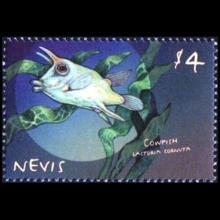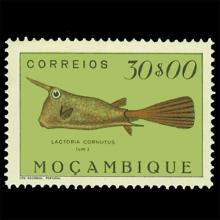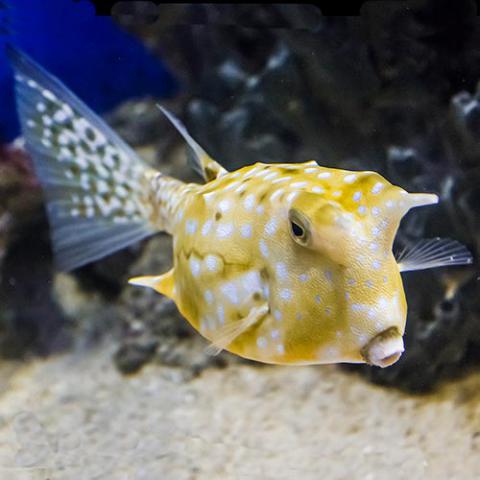NAMES
TAXONOMY
Nevis
Issued:
Stamp:
Lactoria cornuta
Mozambique
Issued:
Stamp:
Lactoria cornuta
Nevis
Issued:
Stamp:
Lactoria cornuta
Mozambique
Issued:
Stamp:
Lactoria cornuta
Nevis
Issued:
Stamp:
Lactoria cornuta
Mozambique
Issued:
Stamp:
Lactoria cornuta
Genus species (Animalia): Lactoria cornuta
The longhorn cowfish (Lactoria cornuta), also called the horned boxfish, is a species of boxfish from the family Ostraciidae, recognizable by its long horns that protrude from the front of its head, rather like those of a cow or bull. They are a resident of the Indo-Pacific region and can grow up to 50 cm (20 in) long.
Adults are reef fish, often solitary and territorial, and live around sand or rubble bottom up to a depth of 50 m (160 ft). They are omnivorous, feeding upon benthic algae, various microorganisms, and foraminiferans that it strains from sediments, sponges, polychaete worms from sand flats, mollusks, small crustaceans, and small fish, able to feed on benthic invertebrates by blowing jets of water into the sandy substrate.
Habitat
Its primary habitat is coral reefs in lagoons, on reef flats, and on protected seaward reefs. Juveniles associate with Acropora corals. Depth range is 3.3–148 ft (1–45 m, perhaps up to 100 m).
Range
Red Sea and East Africa eastward through Indonesia to Marquesas, northward to southern Japan. Including Tuamotus, southern Korea, north to the Ryukyu Islands of southern Japan, south to Australia and Lord Howe Island, and off southern Africa in the Atlantic. Tropical and subtropical waters.
Physiology
There is no known sexual dimorphism, so both male and female display a yellow to olive base color, which is decorated with white or bluish spots. Paired courtship just before or after sunset. Eggs and ichthyoplankton are pelagic.
One distinction from other fish is the lack of a gill cover, which is replaced by a small slit or hole. The hexagonal plate-like scales of these fish are fused together into a solid, triangular, box-like carapace, from which the fins and tail protrude. Their unique method of swimming, called ostraciiform swimming, causes them to look as if they are hovering. They have no pelvic skeleton, so they lack pelvic fins. They are such slow swimmers cowfish are easily caught by hand, making a grunting noise when captured. This is the most well-known cowfish species in the aquarium trade.
Defense
If severely stressed, this species may be able to exude deadly toxin, pahutoxin, an ichthyotoxic, hemolytic, heat-stable, non-dialyzable, non-protein poison in the mucous secretions of their skin. It is apparently unique among known fish poisons; it is toxic to the boxfish and mimics sea cucumber toxins in general properties.
The horns of the Longhorn cowfish may have evolved to make it more difficult to swallow for predators. When damaged, these horns can grow back within a few months. These horns are mostly hollow and composed of mineralized collagen fibers.
Reference: Wikipedia
Photo: commons.wikimedia.org, Nick Hobgood




